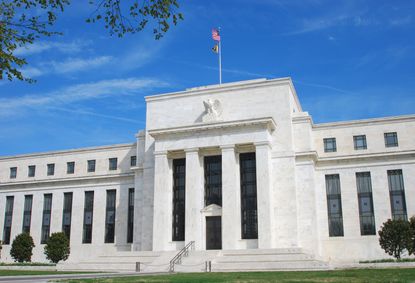If you’ve been paying attention to chatter about rising interest rates, you’ve probably come across the term “federal funds rate” – or just “fed funds rate” for short. But what exactly is the federal funds rate, and why does it matter?
The factors behind this key interest rate can be confusing, but the simplest way to think about the federal funds rate is to consider it as the very first link in the chain for all borrowing across the financial sector. As such, an increase in the fed funds rate means an increase in a host of other interest rates.
This is what makes the fed funds rate a crucial cog in the engine of the U.S. economy, where even small changes in this metric can have meaningful consequences.
Subscribe to Kiplinger’s Personal Finance Be a smarter, better informed investor.
Save up to 74%
Sign up for Kiplinger’s Free E-Newsletters Profit and prosper with the best of expert advice on investing, taxes, retirement, personal finance and more – straight to your e-mail.
Profit and prosper with the best of expert advice – straight to your e-mail.
What is the federal funds rate? To get a full understanding of the fed funds rate, you have to first understand the basics of the U.S. Federal Reserve System.
The Federal Reserve – or simply “the Fed” – provides central control over the nation’s monetary supply and currency. It is one of about 150 central banks on the planet, each designed to guard against financial crises or nudge local economies in the right direction.
Generally, banks make money by taking deposits from customers and lending that cash out again to third parties. A little of this behavior is fine, since it’s rare for every customer to demand their entire deposit back at the same time.
However, to make sure banks have a cushion, the Fed requires a minimum percentage of total deposits to be kept under its oversight. These are the “reserves” that make up the foundation of the Federal Reserve System.
This figure can be just a few million dollars for your favorite local bank, and much higher for major lenders like JPMorgan Chase (JPM) that have billions in deposits. Whatever the bank’s specific threshold is, they must meet it at the end of every day. Banks with more cash than required can lend it to others that come up short, though, and the interest rate on these short-term interbank loans is the federal funds rate.
Why the fed funds rate mattersIf you think overnight loans between two megabanks is merely a behind the scenes detail, think again. Indirectly, this rate impacts everything from mortgages to auto loans to credit cards. And here’s why:
Let’s say that Bank A has to borrow from a competitor’s excess funds to meet its own deposit obligations at the Federal Reserve. If the federal funds rate is fixed at 0.5%, a historically low rate, why wouldn’t it lend aggressively and pay the modest interest expenses to Bank B when it comes up short on deposits?
If the federal funds rate is a costly 5.0%, however, Bank A is far less inclined to borrow from peers. It also is incentivized to keep excess reserves and lend them out to other banks for a tidy profit. And in this higher interest rate environment, banks are much more likely to demand consumers and businesses pay a higher rate on all loans. After all, if an interbank loan is going for 5%, then why would you decide to charge anyone else less than that amount?
How is the federal funds rate set? The Federal Open Market Committee, or FOMC, sets the fed funds rate. There are eight regularly scheduled FOMC meetings throughout the year, and its members include top officials from the U.S. Federal Reserve System. (Find out when the next Fed meeting is here.)
The Fed looks to change policy based on its formal mandate from Congress that is for the central bank to achieve “maximum employment, stable prices, and moderate long-term interest rates.” There are no hard and fast rules on what that means, and it is very difficult to balance all those things perfectly. However, we can generally expect rates to drop if unemployment gets too high and you can expect rates to rise if prices get too high.
In recent decades, the Fed has come to understand the power of the federal funds rate to change investor, business and consumer behavior. As such, the central bank attempts to offer transparency in its process, as well as regular updates and projections to where the federal funds rate could wind up if current trends persist.
The Fed does reserve the right to hold unscheduled FOMC meetings to change rates in an emergency. This happened during the 2008 financial crisis, but also as recently as 2020 due to the unexpected shocks caused by the COVID-19 pandemic.
What is the current federal funds rate? In July 2023, the FOMC raised interest rates by 25 basis points (0.25%), bringing the federal funds rate to a target range of 5.25% to 5.5%. This is the highest it has been since early 2001.
Related contentWhen Is the Next CPI Report?Kiplinger Jobs OutlookKiplinger Interest Rates Outlook
